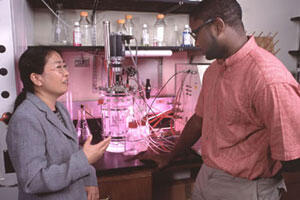April 14, 2003
Engineering professor makes vanillin from corn bran
Share this story
Researchers at the VCU School of Engineering are developing an innovative process to make natural vanillin compound from corn bran without the toxic chemicals used to make the synthetic vanilla added routinely as a flavoring and fragrance to foods, beverages, perfumes and pharmaceuticals.

The results, they hope, will offer an environmentally friendly way to make one of the most widely used flavor compounds in the world. The efforts also are consistent with "green chemistry" initiatives of the Environmental Protection Agency to design chemical products and processes that reduce hazardous substances.
"Vanillin is a key additive to so many food and drug products, but natural vanillin from the vanilla plant can supply less than 1 percent of the world's demand," says Rachel R. Chen, Ph.D., assistant professor of chemical engineering at VCU and the lead researcher on the vanillin project. "The rest comes from synthetic, petroleum-based manufacturing processes that involve toxic chemicals, particularly a carcinogen called dimethyl sulfate.
"We're developing a biotechnology-based process to make vanillin from crop residues that one day might allow us to get away from that petroleum-based process. That's particularly important as we think about vanillin used in food and cosmetics."
The vanilla plant, Vanilla planifolia, is a tropical orchid that is indigenous to Mexico, where tiny hummingbirds and bees pollinate it. It also is grown in Jamaica and other islands in the West Indies, where it is pollinated artificially. The plant produces a vanilla bean that contains a pleasant-smelling compound called vanillin, which is extracted and sold as a flavoring and aromatic additive.
But natural vanilla beans can supply only a tiny fraction of the 12,000 tons of vanillin demanded annually by the world's large food processors and pharmaceutical and tobacco companies to add to everything from candles, fragrances, lotions and cigarettes to cookies, cake icings and other processed foods to cattle feed. Natural vanillin also is very expensive, at $4,000 per kilogram. To fill the demand, industry has turned to synthetic vanilla, which costs about $15 per kilogram.
"There are several problems associated with the synthetic process," says Chen, who outlined her research in late March at a session of the 225th Annual Meeting of the American Chemical Society in New Orleans. "Not only does it involve toxic chemicals, but it also is undesirable because it is derived from petroleum. Despite the huge price difference, it's reasonable to expect a diminishing market for synthetic vanillin as consumers, particularly those in Europe, continue to demand natural and environmentally friendly products."
Scientists have been trying to produce vanillin using natural products for more than a decade, partially spurred by the EPA's Green Chemistry Program, which promotes the use of chemistry for pollution prevention. Vanillin, for example, has been extracted from wood pulp, among other natural products. But the efforts, so far, have not proven to be economically viable.
Chen and her team have been working with corn bran - or the skin of the corn kernel - as a possible source for natural vanillin because of its inexpensive, adequate supply. Corn bran contains a minor amount, about 3 percent, of the vanillin precursor, which can be processed by microbes such as fungi, bacteria or plant cells - in a bioconversion process to make natural vanillin without chemicals. To qualify as natural vanillin in the United States and the Europe, the product must be derived from a natural raw material via biological means and/or mild processing tools, such as extraction and distillation.
Chen has had some success using the precursor to make vanillin. Her big challenge, however, is to find a natural enzyme that will cleave the precursor off the corn fiber.
"I have a lot of concern about the environment," Chen says. "That is the motivation for me to look at renewable sources. If we can find an enzyme to get the precursor out, we can make this process cost effective and compete with the synthetic products. Particularly for food and cosmetics, people care a lot about natural."
Subscribe to VCU News
Subscribe to VCU News at newsletter.vcu.edu and receive a selection of stories, videos, photos, news clips and event listings in your inbox.










